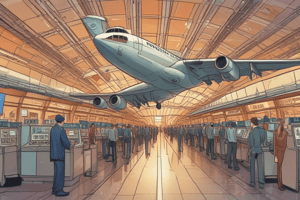Podcast
Questions and Answers
What is the primary purpose of security regulations in aviation?
What is the primary purpose of security regulations in aviation?
- To ensure safety and security in the aviation sector. (correct)
- To regulate ticket pricing.
- To facilitate airline competition.
- To enhance the experience of air travel.
Which organization is responsible for setting global standards for civil aviation security?
Which organization is responsible for setting global standards for civil aviation security?
- Transportation Security Administration (TSA)
- European Union Aviation Safety Agency (EASA)
- International Civil Aviation Organization (ICAO) (correct)
- Federal Aviation Administration (FAA)
What type of regulations primarily address the restriction of access to secure areas in airports?
What type of regulations primarily address the restriction of access to secure areas in airports?
- Incident Reporting Protocols
- Training Requirements
- Screening Requirements
- Access Control Regulations (correct)
Which of the following is NOT a key component of incident reporting protocols?
Which of the following is NOT a key component of incident reporting protocols?
What is a requirement for airport and airline personnel regarding security training?
What is a requirement for airport and airline personnel regarding security training?
How do regulatory authorities ensure compliance with security regulations?
How do regulatory authorities ensure compliance with security regulations?
What aspect is essential for developing comprehensive security programs?
What aspect is essential for developing comprehensive security programs?
Which best practice involves ongoing evaluation of security measures?
Which best practice involves ongoing evaluation of security measures?
Study Notes
Security Regulations in Aviation Security Training
-
Purpose of Security Regulations
- Ensure safety and security in the aviation sector.
- Protect passengers, crew, and cargo from unlawful interference.
-
Key Regulatory Bodies
- International Civil Aviation Organization (ICAO): Sets global standards and regulations for civil aviation security.
- Transportation Security Administration (TSA): Enforces U.S. security regulations and oversees airport and airline security measures.
- European Union Aviation Safety Agency (EASA): Implements safety and security regulations within the EU member states.
-
Types of Security Regulations
- Access Control Regulations: Policies for restricting access to secure areas of airports and aircraft.
- Screening Requirements: Procedures for the screening of passengers, baggage, and cargo to detect prohibited items.
- Incident Reporting Protocols: Guidelines for reporting security breaches or suspicious activities.
-
Training Requirements
- Mandatory training for airport and airline personnel on security protocols.
- Regular updates and refreshers to keep staff informed of new regulations and procedures.
- Specialized training for security personnel, including threat assessment and emergency response.
-
Compliance and Enforcement
- Regular audits and inspections by regulatory authorities to ensure adherence to security regulations.
- Penalties for non-compliance, including fines and revocation of operating licenses.
-
Security Programs
- Development of comprehensive security programs tailored to airport and airline needs.
- Risk assessment processes to identify and mitigate potential security threats.
-
Best Practices
- Continuous monitoring and improvement of security measures.
- Collaboration between various stakeholders, including government agencies, airlines, and airport operators.
-
Emerging Trends
- Incorporation of technology (e.g., biometrics, AI) in security processes.
- Adaptation to evolving threats and dynamic security environments.
Purpose of Security Regulations
- Aim to ensure safety and security within the aviation sector.
- Protect passengers, crew, and cargo from unlawful interference.
Key Regulatory Bodies
- International Civil Aviation Organization (ICAO): Establishes global standards and regulations for civil aviation security.
- Transportation Security Administration (TSA): Enforces security regulations in the U.S. and oversees airport and airline security measures.
- European Union Aviation Safety Agency (EASA): Implements safety and security regulations across EU member states.
Types of Security Regulations
- Access Control Regulations: Policies designed to restrict access to secure areas of airports and aircraft.
- Screening Requirements: Procedures for screening passengers, baggage, and cargo to detect prohibited items.
- Incident Reporting Protocols: Guidelines for reporting security breaches or suspicious activities.
Training Requirements
- Mandatory training for airport and airline personnel on security protocols is essential.
- Regular updates and refreshers keep staff informed about new regulations and procedures.
- Specialized training is provided for security personnel, covering threat assessment and emergency response.
Compliance and Enforcement
- Regular audits and inspections by regulatory authorities ensure compliance with security regulations.
- Non-compliance can lead to penalties such as fines or revocation of operating licenses.
Security Programs
- Development of tailored security programs is crucial for addressing specific needs of airports and airlines.
- Implement risk assessment processes to identify and mitigate potential security threats.
Best Practices
- Continuous monitoring and improvement of security measures is important for effectiveness.
- Collaboration among stakeholders, including government agencies, airlines, and airport operators enhances security efforts.
Emerging Trends
- Increasing incorporation of technology like biometrics and AI in security processes.
- Ongoing adaptation to evolving threats and dynamic security environments is necessary for maintaining safety.
Studying That Suits You
Use AI to generate personalized quizzes and flashcards to suit your learning preferences.
Description
This quiz focuses on essential security regulations in aviation, highlighting key regulatory bodies and their roles in ensuring safety. Learn about access control, screening requirements, and incident reporting to enhance your understanding of aviation security measures.




